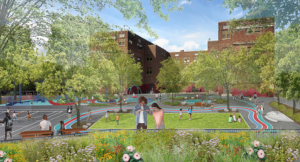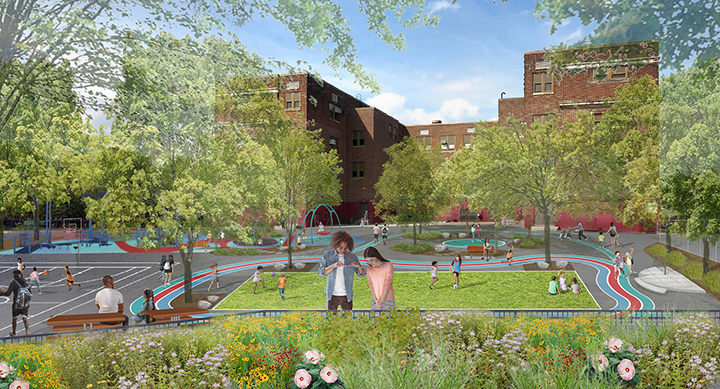
Courtesy of Trust for Public Land
Sustainability has become an extremely hot topic because of the billions of dollars in federal funding available for projects that will protect and extend America’s infrastructure.
Congress and government leaders at every jurisdictional level of government realize that we must upgrade and enhance the country’s basic infrastructure assets. Many diverse federal programs have funding available for any type of project that meets sustainability goals related to infrastructure.
The U.S. Department of Transportation (USDOT) recently allocated another $2.3 billion for transportation-related sustainability projects. In August, USDOT will announce which sustainability projects will receive funding during the 2022 fiscal year.
Awards from last year are already supporting a nationwide slate of large transportation sustainability projects. The Cross Bronx Expressway project in the state of New York was one of the awardees. That project carries a cost estimate of $757 million, and it will include many components with the overall objective of upgrading the existing infrastructure and increasing safety. State officials will release a design plan soon that includes work on a 2.4-mile portion of the expressway, and contractors will be asked to submit proposals shortly after that.
Another $10 million grant from USDOT’s 2021 funding cycle is fueling progress on a $57 million intermodal facility project in Detroit. Plans for the new facility include sustainable reconstruction of rail and intercity bus stations, rail consolidation, upgrades to expanded motor coach bus services, and more. The reconstructed intermodal facility will bring outdated infrastructure into good repair and improve accessibility features and efficiency of travel. State officials plan to issue a request for Design-Build-Operate-Maintain proposals in 2023.
Funding for sustainability projects also is available at the state levels of government. The governor of Colorado has pledged to convert the entire state to renewable energy by 2040. That initiative will span years, but currently there is $5 million available to begin incentivizing local governments leaders to launch projects that result in sustainable, clean energy infrastructure. Recently, the state disbursed $3 million for a conceptual plan for a microgrid in Pitkin County. Other funding which will be used for planning purposes has been distributed to the city of Craig and the county of Gunnison. State leaders hope to see numerous new sustainability projects announced soon.
Rather than waiting for support from federal or state officials, many local leaders are moving on their own to launch sustainability initiatives. In Florida, municipal sustainability plans related to the Race to Zero initiative are common. The program encourages cities to coordinate sustainability plans designed to help the state achieve carbon neutrality. Now Miami, one of the participating cities, is requiring all new buildings to be solar-ready and storage-ready by 2024 to meet Race to Zero goals.
The Philadelphia Water Department will partner with the city’s Office of Sustainability to launch numerous sustainability projects. The Nichols Park project is scoped to improve stormwater management with sustainable, green infrastructure measures such as rain gardens and tree trenches designed to retain excess water during storm surge flooding. Design work is underway on the project.
Similar stormwater-related projects in Pennsylvania include the Lindbergh Traffic Triangle, the Cobbs Crossing Rain Garden, and three phases of the Hunting Park Cool Cover plan. All three initiatives are in design phases.
Sustainability funding of $7.2 million is allocated for planning, design, development, repair, and replacement of multi-use trails in the city of Des Moines, Iowa. Beginning in the 2024 fiscal year, the city will begin a long-range initiative to resurface and repair the city’s 70 miles of paved trails, 19 miles of biking trailways, and 11 trail bridges. The effort will include drainage improvements, fog-sealing, and erosion repairs.
The city also will invest $900,000 to upgrade street light fixtures with more energy efficient lights. All streetlights in the Western Gateway district and along all city-owned bridges will receive new LED lights. The project matches sustainability goals by expanding green infrastructure and enhancing safety with more energy efficient roadway lighting.
In Arlington County, Virginia, sustainability is a significant component of a $16 million project to upgrade infrastructure along Army Navy Drive. The work will install green infrastructure to improve stormwater management. It also will include protected bike lanes and safer pedestrian crossings. The project is in its design stage and will proceed to construction between 2023 and 2024.
The Virginia county of Henrico also is planning sustainability projects. A multi-phased Fall Line Trail project is in the design phase. The plan will feature upgrades of several pedestrian bridges and provide an extension of existing trails throughout the county. The $10 million project meets sustainability goals because it builds on existing infrastructure county assets and offers alternatives to carbon-emitting forms of transportation.
Infrastructure projects that meet sustainability goals are abundant throughout the country. Government leaders are making an historic effort to adopt sustainability strategies that ensure responsible stewardship of public assets related to infrastructure.







